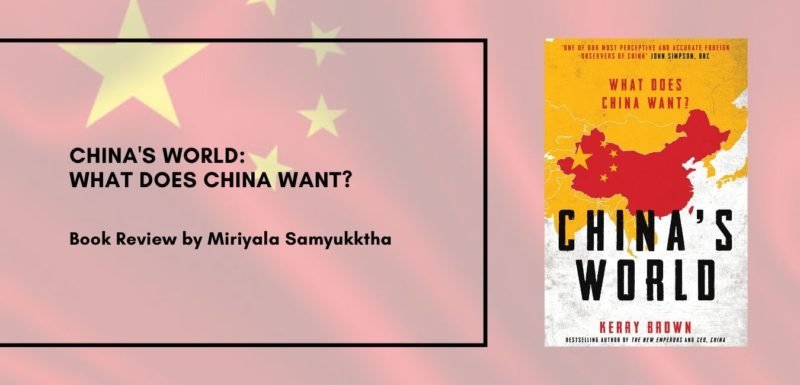China’s World: What Does China Want?

To better understand China and Chinese behaviour in International space, it is important to study the History of China and its foreign policy behaviour. While there are many books written on Chinese foreign policy, most of them are hard reads, complex to understand, and most importantly require prerequisite knowledge of China or international relations. This leaves many people interested in the subject in the dark, making them feel China is a complex country to Understand.
Kerry Brown adopted a rather simplistic and easy method in an attempt to explain Chinese foreign policy to a larger set of audiences. Kerry Brown is Professor of Chinese Studies and Director of the Lau China Institute at King’s College London and Associate on the Asia Programme at Chatham House. He has also worked for a term as First Secretary at the British Embassy in Beijing.
As a close observer of China in the field, Kerry brown throws a huge amount of light on Chinese decision making in the field of foreign policy. The book is thus, written from a Chinese perspective. China’s moves and foreign policy objectives are interpreted by understanding the inner workings of China and the Communist Party of China (CPC).
In this book, Kerry Brown attempts to explain Chinese foreign policy by examining various stakeholders in its foreign policy. The first two chapters discuss ‘The principles of Chinese Foreign Policy’ and ‘The World According to Xi Jinping’ respectively. After establishing a brief introduction into Chinese thinking, intentions, desires and objectives, the author states that China views the world in terms of four zones.
Each Zone is covered chapter wise. Zone 1 being the area of highest strategic importance to Chinese policies and Zone 4 being the last one in order of priorities. The USA is categorized as the 1st Zone; Zone 2 is the Asia Region followed by European Union (EU) in Zone 3; and the wider world in Zone 4.
In the first chapter, ‘The Principles of Chinese Foreign Policy’, Brown covers the various actors involved in the decision-making process of Chinese foreign policy. He notes that People’s Liberation Army (PLA), the Ministry of State Security (MSS), the Central Military Commission (CMC), leading state and non-state companies in China, top universities, intellectuals, and think tanks are “movers and shakers” of their foreign policy, explaining each of their roles or influence in detail. However, the core driving force of Chinese foreign policy lies with President Xi Jinping, he concludes.

In the second chapter, ‘The World According to Xi Jinping’, the author first talks about the greatness of Mao Zedong and the way he shaped China. The author provides insights into various provinces of China like Suzhou, Zhuhai, Shanghai, Guangdong, Zhejiang and Fujian. Coastal provinces, trade, logistics, investment links, their local governments and other key issues of these provinces are discussed in a unique and informative manner.
With this discussion, the author attempted to provide a sociological approach in understanding the Chinese people’s lives which, in turn, reflects their perspective about various foreign policy decisions.
The author strikes a rather compelling note saying, “China has not moved much further than the era of Mao Zedong when, once again, only a handful of people really mattered, and only one, Mao himself, was truly decisive. China under Xi is only a little better.”
The next chapter deals with Zone 1: The United States of America. The United States is an important country for China. Its economic power is important to China, and it is its largest export market. But it is also its greatest security rival, with a military that is technically far ahead of China. The author explores in this chapter how the United States missed strategic opportunities in democratising China.
America’s effort to integrate China into the liberal international order now generated threats to US supremacy. The chapter gives recommendations to the US on counterbalancing China.
Chapter 4 deals with Zone 2: The Asia Region. In this chapter, the author deals with China and Japan Relationship in depth. North Korea and China’s inseparable relationship is examined. Analysts claim that North Korea friendship is a part of a larger geopolitical strategy aiming to constrain the United States strategic space, pre-occupy and distract its allies Japan and South Korea. Multiple perspectives have been given in examining both the relationships.
Apart from these two, China’s maritime issues, its equation with India, Pakistan, Russia, Central Asia, ASEAN, further including the Belt and Road Initiative have been discussed. Upon examining various angles of the BRI dynamics, the author concludes that in terms of reputation, image and trust, China seems unable to remove deep-seated opposition and suspicion, which might hamper its BRI interests.
Zone 3 covering the EU positively covers themes over the economy, mutual dependency, and battles over markets, values and knowledge. The next chapter on Zone 4 covers China in Africa, the Middle East, Latin America and the Arctic and Antarctica.
In Africa, Middle East and Latin America, China has no specific policy towards them but aims to cater them to its economic advantages. In Africa, it is insistent that the country’s engagement is all about material help and commercial partnership rather than supplying any ideological support. Similarly, if the Middle East has no oil reserves, China would almost certainly stand back from any significant commitment.
A report made clear in 2013, that there might be around 200 million barrels of oil in the Arctic and Antarctic region. It was for this reason, the author states, that China believes it should ‘take advantage of ocean and polar resources’.
Over Latin America, China shares weak historic and cultural links. Latin American and Caribbean countries have been communist and Mao Zedong had links with Che Guevara. However, today China views the region as nothing but a good foundation for economic and social growth and huge development potential.
To conclude, the author states “A good outcome could see an extraordinary moment when a nation which was almost crushed and annihilated by invasion and slaughter in the middle of the twentieth century becomes the key shaper of the twenty-first. If it achieves this, in ways which are harmonious, consensual and supported by the rest of the world, it will be a true victory for humanity”.
The author covered the foreign policy of China in terms of countries and zones attempting to cover the most important aspects of its foreign policy. However, he failed to explore a few other important aspects of Chinese foreign policy like discussing China’s military developments, the disputes over Hong Kong and Taiwan, and its String of Pearls strategy.
The author should have explored why China did not resolve its border issues with India, while it resolved all other territorial disputes it had with other countries.

In discussing the rise of China to become a global superpower, author opinionates that China’s rise to such a position is difficult to achieve, due to the simple fact that no one supports China’s rise. Rise of a superpower simply does not come from economic might or military power. It is very difficult to involve China in international issues that have no stakes for it. The international community and the citizens of the world look upon China with suspicion and mistrust. It cannot be acknowledged as the leader of the world.
Overall, the book is a good read to get a picture of what China means to the world and what the world means to China. The book’s coverage is horizontal in nature i.e., the book aims at covering various aspects of a particular topic or issue but does not aim at exploring a single aspect or topic in detail or answering a particular research question in depth.
The book is clear, well written and organized. It covers various aspects or stakeholders of Chinese foreign policy aiming to give a holistic view of it. It is detailed without being heavy and exemplifies an impressively broad understanding of this complex field.


















